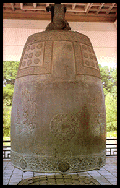 |
Traditional Korean Music Pages Religious Music of Korea |
 |
|
|
|
Religious Music Forms |
Buddhism was brought to Korea from China late in the 4th century, where it harmonised with Korean culture and a Korean form of Buddhism emerged. During the Unified Shilla Dynasty, Buddhism was supported by the state and embraced by the people. Buddhist festivals at that time drew great crowds of people who would gather to perform elaborate Buddhist ceremonies which included music and dance. Later during the Koryo Dynasty, Buddhism continued to develop and played a significant role in the cultural growth of the nation. In the late 14th century however, the Chosun Dynasty took control of Korea and adopted Confucianism in favour of Buddhism. One major reason for this is that Buddhist temples had accumulated a great deal of land and material wealth, forcing the closing of temples meant that the court could take control of the land and seize the material objects kept in the temples. |
2. Confucian MusicAn annual ceremony honouring Confucious is held at the Confucian Shrine in Seoul, the ceremony includes instrumental music, vocal music, and dance. The music was brought to Korea from China's Song Dynasty during the Koryo Dynasty around the year 1116. After some centuries the music became Koreanised, thus in the 15th century King Sejong decided to restore the music to its original form as it had existed in China. Today it is performed from the notation which has been passed down since the 15th century. The music used in the Confucian Shrine Ceremony consists of six pieces constructed on a 7-tone scale in melismatic form. Like the Royal Ancestral Shrine music this ceremony employs two full orchestras: deungga (terrace orchestra) and hunga (courtyard orchestra), notably the hunga does not use a single string instrument. |
For centuries Korean people have cultivated shamanism, developing a large collection of lively mystical performance rituals. The musical elements include vocal songs, instrumental accompaniment, and purely instrumental pieces, such as sinawi. The rituals are normally led by a single shaman accompanied by a small energetic instrumental troupe. Rituals are performed for several purposes, such as sending wishes or appeals to the gods, to contact the souls of ancient people, or simply to entertain and appease the gods. The musical characteristics of these shaman rituals differ somewhat according to region much like the various folk song styles. A number of shaman songs have become quite popular and have essentially been assimilated into the general folk music tradition. |